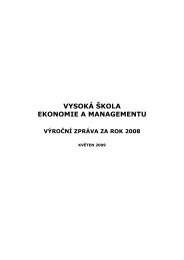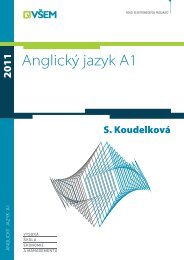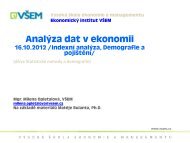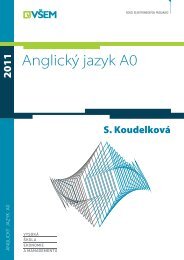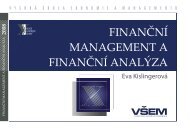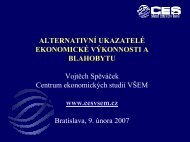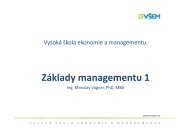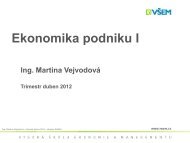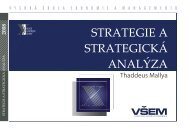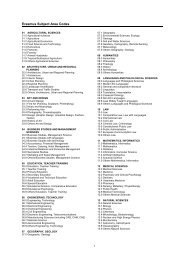- Page 1 and 2:
Milan Žák (Ed.)
- Page 3 and 4:
Editor: Prof. Ing. Milan Žák, CSc
- Page 6 and 7:
ÚVOD Čtenáři předkládaná pub
- Page 8 and 9:
CO NEZACHYCUJE HDP: ALTERNATIVNÍ C
- Page 10 and 11:
1. NÁRODNÍ ÚČTY - ZÁKLADNÍ N
- Page 12 and 13:
ýt doplnění základních účtů
- Page 14 and 15: objemové indexy HDP vyjadřují do
- Page 16 and 17: né konvergence. Na tempa růstu HD
- Page 18 and 19: projevují kvalitativní změny v u
- Page 20 and 21: vyvinula. Od počátku 80. let Bure
- Page 22 and 23: vycházejí z běžných vah. V let
- Page 24 and 25: více či méně kapitálově náro
- Page 26 and 27: y, pro které se používá několi
- Page 28 and 29: Ve světě propojených dodavatelsk
- Page 30 and 31: porovnání jednotlivých složek h
- Page 32 and 33: jež firmy vykazují, nereprezentuj
- Page 34 and 35: ge a dřívější člen sboru pora
- Page 36 and 37: gátní jednotkové pracovní nákl
- Page 38 and 39: přerozdělení důchodů mezi odb
- Page 40 and 41: Mezi ekonomicky vyspělými zeměmi
- Page 42 and 43: v ekonomické úrovni nižší mír
- Page 44 and 45: důchodu nabývá stále většího
- Page 46 and 47: V České republice jsou obchodní
- Page 48 and 49: na 9. místo. 25 V čele (hned za a
- Page 50 and 51: V roce 2009 došlo k významným zm
- Page 52 and 53: epublika a Slovensko. V nejslabší
- Page 54 and 55: 3.3 Relace alternativních ukazatel
- Page 56 and 57: ho charakteru zboží služeb. Pro
- Page 58 and 59: nomické úrovni. (Skutečná indiv
- Page 60 and 61: Institute for International Economi
- Page 62 and 63: EMPIRICAL TESTS OF THE RELATIVE PPP
- Page 66 and 67: exchange rates and/or misalignments
- Page 68 and 69: MacDonald's study (1998) includes t
- Page 70 and 71: Figure 1: Exchange rate determinati
- Page 72 and 73: Twelve CEE countries (the NMS witho
- Page 74 and 75: The absolute PPP can be formally wr
- Page 76 and 77: 1.4 Estimation strategy The relativ
- Page 78 and 79: expected, 29 some of the NMS countr
- Page 80 and 81: adjusted to the case of structural
- Page 82 and 83: 1. all coefficients are tested via
- Page 84 and 85: 2002, LLC) 39 works with the equati
- Page 86 and 87: for panels to eliminate cross-secti
- Page 88 and 89: quarterly time series were not avai
- Page 90 and 91: of the PP, KPSS and DF-GLS tests 58
- Page 92 and 93: structural breaks might result in l
- Page 94 and 95: the so-called first generation (e.g
- Page 96 and 97: Table 7: Univariate unit root test
- Page 98 and 99: To begin with, univariate URTs are
- Page 100 and 101: Intercepts and deterministic trends
- Page 102 and 103: is medium) while the number of peri
- Page 104 and 105: test allows us to reject the at sig
- Page 106 and 107: These are the individual thresholds
- Page 108 and 109: Table 14: Spearman's rank correlati
- Page 110 and 111: parameter heterogeneity). Additiona
- Page 112 and 113: CONCLUSIONS This paper focused on t
- Page 114 and 115:
REFERENCES Alba, J. D., Park, D.: A
- Page 116 and 117:
Candelon, B., Kool, C., Raabe, K.,
- Page 118 and 119:
GGDC: Groningen Growth and Developm
- Page 120 and 121:
Koukouritakis, M.: Testing the purc
- Page 122 and 123:
Taylor, A. M., Taylor, M. P.: The P
- Page 124 and 125:
2) Results for subgroups of the NMS
- Page 126 and 127:
B) Exchange rate regimes in the NMS
- Page 128 and 129:
Table 21: Panel unit root tests - c
- Page 130 and 131:
Table 23: Panel unit root tests - c
- Page 132 and 133:
Table 25: Panel unit root tests - c
- Page 134 and 135:
133
- Page 136 and 137:
Source: see text. 135
- Page 138 and 139:
137
- Page 140 and 141:
Source: see text. 139
- Page 142 and 143:
Source: see text. 141
- Page 144 and 145:
Table 27: Summary statistics - for
- Page 146 and 147:
F) Lag specification Table 29: Sugg
- Page 148 and 149:
INSTITUCIONÁLNÍ SEKTORY V ČESKÉ
- Page 150 and 151:
Komise evropských společenství (
- Page 152 and 153:
lýzu ekonomického chování (tak
- Page 154 and 155:
ťování, kde se přeměňuje indi
- Page 156 and 157:
Účet užití disponibilního důc
- Page 158 and 159:
Účet užití disponibilních důc
- Page 160 and 161:
dů, prvotního a druhotného rozd
- Page 162 and 163:
jících na základě živnostensk
- Page 164 and 165:
Tabulka č. 4: Podíl náhrad zamě
- Page 166 and 167:
HDP), následovaném Irskem (témě
- Page 168 and 169:
3.4 Disponibilní důchod a jeho u
- Page 170 and 171:
Pro sektor domácností jsou nejvě
- Page 172 and 173:
Tabulka č. 13: Podíl sektorů na
- Page 174 and 175:
nancování nefinančních podniků
- Page 176 and 177:
Analýza těchto ukazatelů v obdob
- Page 178 and 179:
jích, především bankovních úv
- Page 180 and 181:
Tabulka č. 17: Míra investic nefi
- Page 182 and 183:
ních účtů (ESA 1995) a ČSÚ dv
- Page 184 and 185:
Tabulka č. 20: Vládní deficit (v
- Page 186 and 187:
nancí a vládními dluhy jako je I
- Page 188 and 189:
cům, provozní přebytek, smíšen
- Page 190 and 191:
o 59 % (o 5,3 % průměrně ročně
- Page 192 and 193:
Mezinárodní srovnání míry úsp
- Page 194 and 195:
Nové členské země EU ze středn
- Page 196 and 197:
financování z úspor ostatních s
- Page 198 and 199:
POUŽITÁ LITERATURA ČNB (2010): Z
- Page 200 and 201:
DISPARITY REGIONÁLNÍHO BOHATSTVÍ
- Page 202 and 203:
obyvatele. Pro zachycení blahobytu
- Page 204 and 205:
vaných statků a služeb ve všech
- Page 206 and 207:
oproti jiným zemím příliš velk
- Page 208 and 209:
Přes výše uvedené skutečnosti
- Page 210 and 211:
(např. Středočeský kraj) byl v
- Page 212 and 213:
produkci na úroveň, které by nem
- Page 214 and 215:
ní hodnotě ČDDD. Tabulka č. 8 p
- Page 216 and 217:
Tabulka č. 9: Regionální průmě
- Page 218 and 219:
Kraj Struktura jednotlivých slože
- Page 220 and 221:
V případě, že se takové porovn
- Page 222 and 223:
Na základě experimentálních pro
- Page 224 and 225:
důchodu relativně méně přízni
- Page 226 and 227:
vyvodit závěr, že prohlubování
- Page 228 and 229:
ekonomický výkon, ale jeho pracov
- Page 230 and 231:
POUŽITÁ LITERATURA BEHRENS, A. (2
- Page 232 and 233:
MEZINÁRODNÍ OBCHOD V PROSTŘEDÍ
- Page 234 and 235:
ozdílného vybavení zemí výrobn
- Page 236 and 237:
důsledkem širší změny v ekonom
- Page 238 and 239:
Box č. 1: Aktivity podniků pod za
- Page 240 and 241:
V počátečním stadiu přílivu P
- Page 242 and 243:
vztahů (jak tuzemských, tak i mez
- Page 244 and 245:
3. GLOBALIZAČNÍ JEVY V MEZINÁROD
- Page 246 and 247:
ních sítí znamenají, že firmy
- Page 248 and 249:
cování dat, výzkumné a konzulta
- Page 250 and 251:
4.2 Obchodování bez změny vlastn
- Page 252 and 253:
Obrázek č. 7: Schéma obchodován
- Page 254 and 255:
prodají zahraničním firmám zbo
- Page 256 and 257:
nerezidenta, a následně vyvezeno
- Page 258 and 259:
tice, zásoby a vývoz). Bilanční
- Page 260 and 261:
LITERATURA ARNDT, S. W. - KIERZKOWS
- Page 262 and 263:
PRICE, V. C. (2001): Some Causes an
- Page 264 and 265:
LOBOVÁNÍ - PROSAZOVÁNÍ ZÁJMŮ
- Page 266 and 267:
Box č. 1: Lobby Lobby je slovo ciz
- Page 268 and 269:
cializovaná a odborná reprezentac
- Page 270 and 271:
metody a styly lobbování. I když
- Page 272 and 273:
skupin - nëkdy také označované
- Page 274 and 275:
zájmových skupin umožňuje záko
- Page 276 and 277:
3. LOBBING A JEHO SNAHY O REGULACI
- Page 278 and 279:
podrobné prohlášení o svých pr
- Page 280 and 281:
Box č. 2: Reakce Evropského parla
- Page 282 and 283:
kteří pro në pracují. To znamen
- Page 284 and 285:
Průzkum provádëný v roce 2001
- Page 286 and 287:
Z hlediska ČR byl průzkum zajíma
- Page 288 and 289:
lobbistů k seberegulaci a k regula
- Page 290 and 291:
5. LOBBING, KORUPCE A HODNOCENÍ IN
- Page 292 and 293:
Tato souhrnná hodnocení sice char
- Page 294 and 295:
efektivnost využití zdrojů a tí
- Page 296 and 297:
PŘÍLOHY Příloha č. 1: Pravidla
- Page 298 and 299:
POUŽITÁ LITERATURA ALTER-EU 21. 3
- Page 300 and 301:
COM (2006) 194: Green Paper. Europe
- Page 302 and 303:
FIALA, P. (1997): Funkce zájmovýc
- Page 304 and 305:
HREBENAR, R. J., McBETH, C.H., MORG
- Page 306 and 307:
Lobbying Needs Sensible Rules (2007
- Page 308 and 309:
gic Use of Information and Money to
- Page 310 and 311:
SCHMITTER, C. P. (2004): Neo - Neof
- Page 312 and 313:
METODIKY A METODY ŘÍZENÍ PODNIKO
- Page 314 and 315:
Service Operation řeší problemat
- Page 316 and 317:
1.3 ITGPM Model ITGPM je rovněž o
- Page 318 and 319:
strategických úloh, např. strate
- Page 320 and 321:
formance Management). Existuje něk
- Page 322 and 323:
V dalším přehledu jsou jednotliv
- Page 324 and 325:
procesy v informatice jsou specific
- Page 326 and 327:
Vstupy procesu: informační strat
- Page 328 and 329:
tovaným na řízení informatiky.
- Page 330 and 331:
42 % odpovědí) kombinaci více mo
- Page 332 and 333:
competitive intelligence, customer
- Page 334 and 335:
Z výsledků uvedeného průzkumu l
- Page 336 and 337:
(činnostmi a jejich vazbami), čas
- Page 338 and 339:
k tomu, že se služby dnes považu
- Page 340 and 341:
Metody analýzy a plánování info
- Page 342 and 343:
UČEŇ, P. (2008): Zvyšování vý
- Page 346:
ISBN 978-80-7201-841-3




